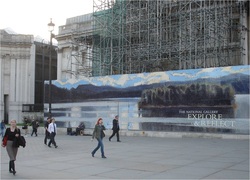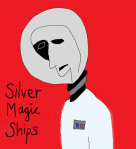
The exhibition explores altarpieces - their construction, commission and construal. It also tackles "the business of altarpiece design". It has far less to say about the business of altarpiece acquisition.
This silence is achieved by a careful process of exclusion, as is apparent in the room entitled "Dislocation". It is introduced as follows:
The objects in this room are all fragments of different altarpieces. Some altarpieces were
modified or updated quite early in their history to appeal to the prevailing tastes of the time.
The majority, however, were dismantled following the suppression of religious institutions
across Italy during the late 18th and early 19th centuries.
Altarpieces that were not directly transferred to art galleries in Italy appeared on the art market,
encouraging the attention of scholars and collectors. This room examines the various methods
used by art historians, conservators and scientists to reconstruct and recontextualize these
altarpiece fragments.
This seemingly unremarkable statement of facts neglects to mention something that is raised in the accompanying catalogue. The chapter "Dislocation, dismembering and dismantling" begins with a reproduction of Niccolò di Liberatore's Christ on the Cross, and Other Scenes (1487). It was purchased by the National Gallery in 1881. Rumours that it had been stolen prior to its acquisition were "somewhat mysteriously" dropped (Nethersole 2011: 93). This example is used to illustrate "the potentially dubious machinations that sometimes characterised the sale of Italian pictures in the nineteenth century." The catalogue's author continues: "The art market responded to the demand for Italian "primitives" by ruthlessly hacking them up, extracting saleable elements and discarding the rest" (Nethersole 2011: 93).
So, instead of a backdrop of sacred music, might it not be more appropriate if the National Gallery's hallowed halls reverberated to the sound of saws cutting wood?
How do we account for the difference between the interpretation in the gallery and in the book? Well, opting to overlook the "dubious machinations" of the art market minimises the risk of gallery-goers asking awkward questions. Any critical reactions arise at a safe distance: namely when the interested visitor sits down at home to flick through the glossy new addition to their library.
Is this deception by interpretive design acceptable for a museum that markets itself under the mantra: "EXPLORE & REFLECT"? It is questionable whether the dissimulation evident in Devotion by Design accords with the museum's own Research code of conduct: "Good conduct in the context of research practice at the Gallery includes... [a]pplying the highest possible standards of integrity and professionalism, including observing relevant legal and ethical requirements."(1)
By marginalising legal and ethical questions the museum has presumably sought to safeguard the sacred aura of the museum. The realisation that the National Gallery has played a decidedly dubious role in the dislocation, dismembering and dismantling of religious artefacts is disturbing. But that should not make it a taboo topic for a museum visit.
The museum's curators clearly need to worship at the altar of the Church of Earthalujah and heed the words of the Rev Billy: "Blessed are you who disturb the customers, for you might be loving your neighbor."
The National Gallery ought to reward its visitors with just such disturbing love.
___
Note
(1) National Gallery Code of Practice and Good Conduct in Research, accessed 17/09/2011 at, http://www.nationalgallery.org.uk/paintings/research/research-code-of-conduct
_________
References
Elliott, Mark (2002) "Magic House: Sacred Space and Profane Behaviour in the Indian Museum, Calcutta",
World Art Symposium, School of World Art Studies and Museology at the University of East Anglia,
19/01, accessed 17/09/2011 at, http://www.uea.ac.uk/~t013/Sacred%20Places/Magic_house.htm
Nethersole, Scott (2011) Devotion by Design: Italian Altarpieces before 1500, London, National Gallery Company





